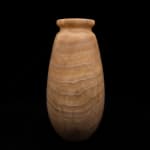Late Period Alabastron, 664 BC - 323 BC
Alabaster
25.3 x 11.5 cm
10 x 4 1/2 in
10 x 4 1/2 in
ES.3456
Further images
-
(View a larger image of thumbnail 1
)

-
(View a larger image of thumbnail 2
)

-
(View a larger image of thumbnail 3
)

-
(View a larger image of thumbnail 4
)

-
(View a larger image of thumbnail 5
)

-
(View a larger image of thumbnail 6
)

-
(View a larger image of thumbnail 7
)

-
(View a larger image of thumbnail 8
)

Alabastron vessel featuring an elongated 'drop-shaped' body tapering upwards into a barely suggested shoulder and a contracted neck terminating into a heavily rimmed lip. A soothing, rhythmic motion in the...
Alabastron vessel featuring an elongated 'drop-shaped' body tapering upwards into a barely suggested shoulder and a contracted neck terminating into a heavily rimmed lip.
A soothing, rhythmic motion in the grain of this alabastron grants it an undecorated simplicity that is extremely calming and aesthetically pleasing to the eyes. Dark flowing bands highlight softer creamy waves that form a harmonious natural horizontal pattern in the stone. The alabastron's carving has been perfected to a high degree revealing an unsurpassed natural beauty and technical excellence. despite its size and girth, the vessel has a delicacy that is brought about by the refined articulation of its profile. The dramatic tones and surface patterning enliven the vessel's surface to create a unique work of art.
Alabaster jars with these distinctive lug handles and underlying triangular ornamentation are linked to Egypt's 27th dynasty. This assigns our vessel to a comparative date of the 5th century BC. During this time Egypt was controlled by the Persians. Xerxes the Great was the Achaemenid king and third ruler of the 27th dynasty. In 525 BC, Egypt fell under the yoke of Persia and would have been governed by Persian Kings for about 200 years. A wealth of information has been passed down, especially by Herodotus on this particular period; Xerxes was famous for his battles against the Greeks at the Thermopylae and Salamis. Again according to Herodotus, his rule over Egypt was rather harsh, nevertheless traditional forms with some stylistic changes were still created for the upper classes and official purposes.
Egyptian alabaster vessels were owned by the wealthy, served as royal paraphernalia for ritual libations and for the storage of oils, ointment, cosmetics and other costly substances. The interior of our alabastron is far smaller than its exterior would lead us to believe; possibly it contained expensive and precious materials, protected by its thick wall.
A comparable example datable to the 6th century BC, even if not as substantial in size, is in the permanent colletion of the National Museum in Kassel, Germany. See Felgenhauer, A, Agyptische und Agyptisierende Kunstwerk, Staatliche Museen Kassel, 1996: no.12-14.
For further information on alabastra see Aston, B. Ancient Egyptian Stone Vessels: Materials and Forms, Heidelberg, 1994; and Lyliquist, C. Egyptian Stone Vessels: Khian through Tuthmosis IV, New York, 1995.
A soothing, rhythmic motion in the grain of this alabastron grants it an undecorated simplicity that is extremely calming and aesthetically pleasing to the eyes. Dark flowing bands highlight softer creamy waves that form a harmonious natural horizontal pattern in the stone. The alabastron's carving has been perfected to a high degree revealing an unsurpassed natural beauty and technical excellence. despite its size and girth, the vessel has a delicacy that is brought about by the refined articulation of its profile. The dramatic tones and surface patterning enliven the vessel's surface to create a unique work of art.
Alabaster jars with these distinctive lug handles and underlying triangular ornamentation are linked to Egypt's 27th dynasty. This assigns our vessel to a comparative date of the 5th century BC. During this time Egypt was controlled by the Persians. Xerxes the Great was the Achaemenid king and third ruler of the 27th dynasty. In 525 BC, Egypt fell under the yoke of Persia and would have been governed by Persian Kings for about 200 years. A wealth of information has been passed down, especially by Herodotus on this particular period; Xerxes was famous for his battles against the Greeks at the Thermopylae and Salamis. Again according to Herodotus, his rule over Egypt was rather harsh, nevertheless traditional forms with some stylistic changes were still created for the upper classes and official purposes.
Egyptian alabaster vessels were owned by the wealthy, served as royal paraphernalia for ritual libations and for the storage of oils, ointment, cosmetics and other costly substances. The interior of our alabastron is far smaller than its exterior would lead us to believe; possibly it contained expensive and precious materials, protected by its thick wall.
A comparable example datable to the 6th century BC, even if not as substantial in size, is in the permanent colletion of the National Museum in Kassel, Germany. See Felgenhauer, A, Agyptische und Agyptisierende Kunstwerk, Staatliche Museen Kassel, 1996: no.12-14.
For further information on alabastra see Aston, B. Ancient Egyptian Stone Vessels: Materials and Forms, Heidelberg, 1994; and Lyliquist, C. Egyptian Stone Vessels: Khian through Tuthmosis IV, New York, 1995.







